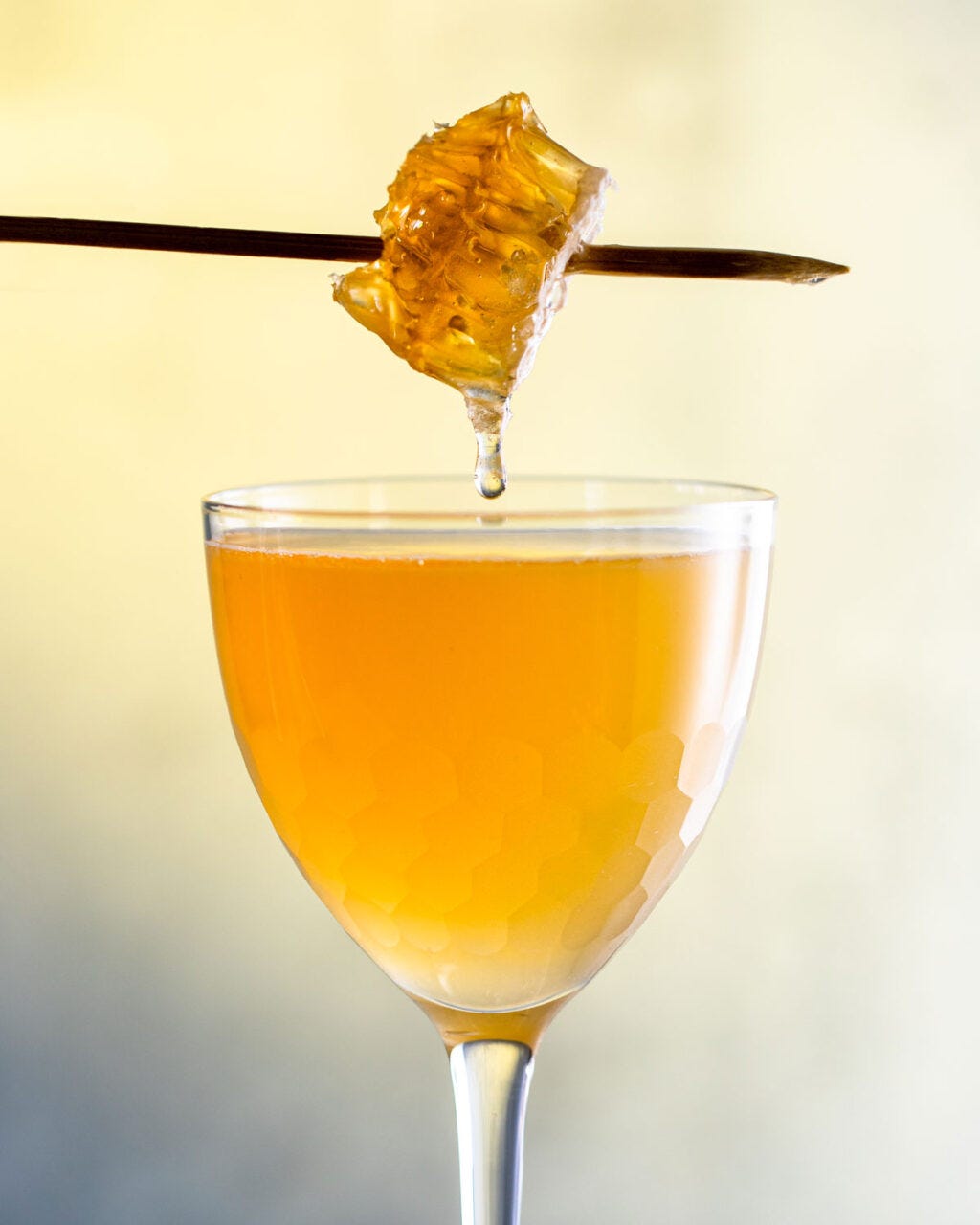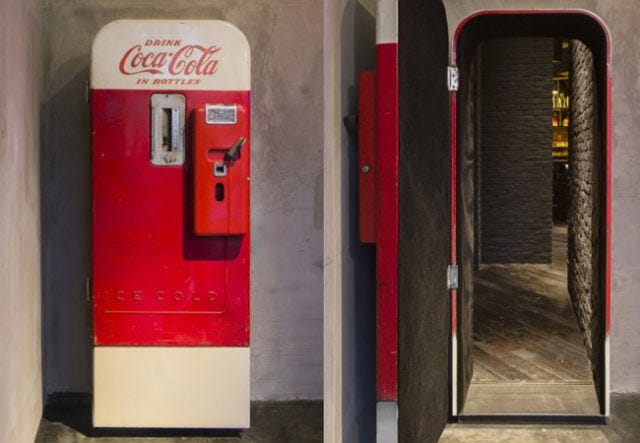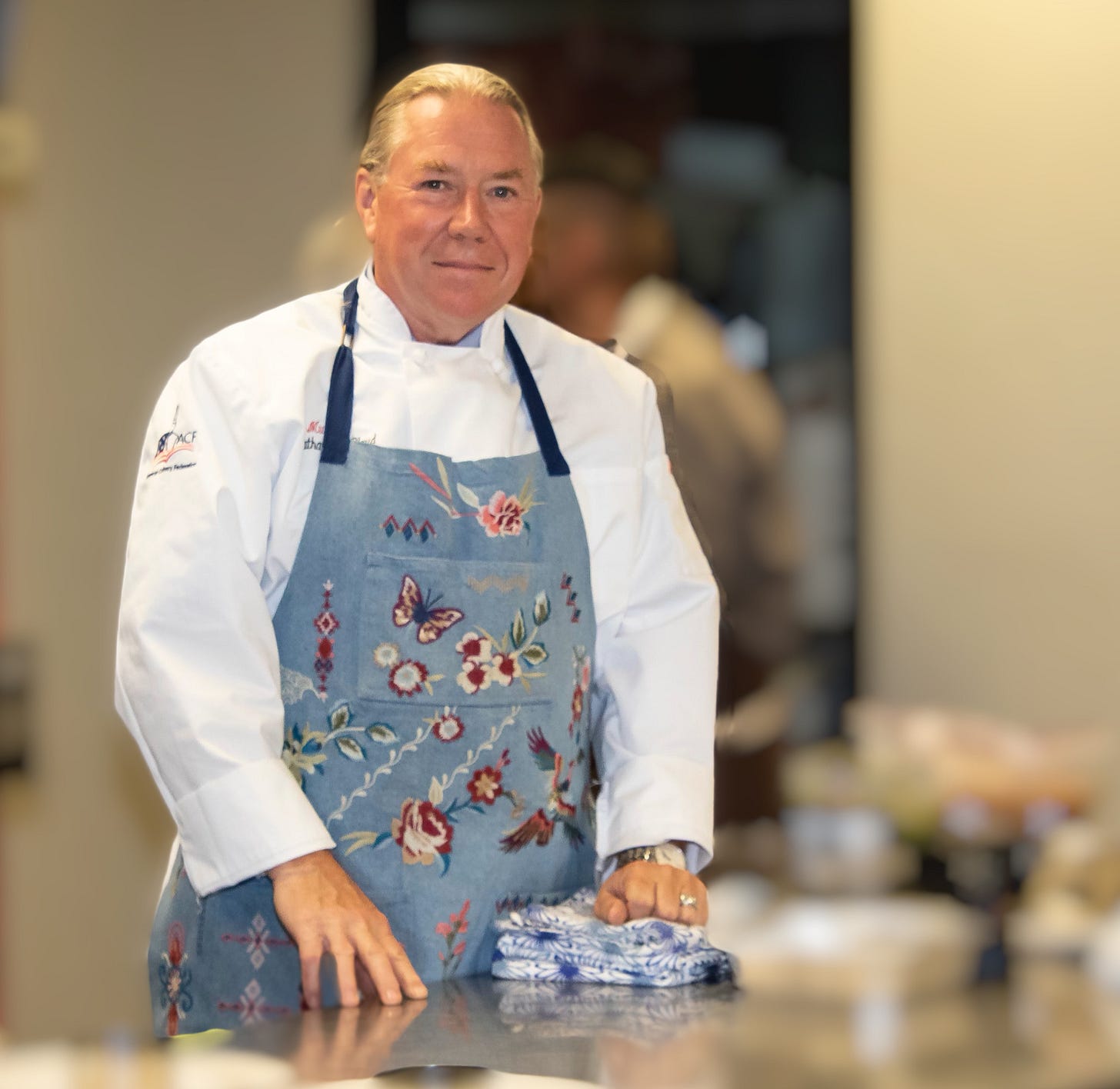Cocktail Hour @ The Intentional Table
Libations to make the heart and conversation grow warmer.
Greetings! It’s Cocktail Hour at the Intentional Table!
The Surprising Truth Behind Your Favorite Cocktails' History (well, maybe surprising)
Cocktails have a richer history than most people realize. The first printed reference appeared in an American publication on May 13, 1806. These drinks started as a simple "stimulating liquor composed of spirits of any kind, sugar, water, and bitters." The concept has grown remarkably over the centuries while retaining its social importance.
Yes, the bar section of the Intentional Table is still there, but it is not quite as robust as it once was. Several things have happened since we’ve been in business around here (62 years now), and I would say that these days, we are more about quality than quantity. This was not always the case when I was in my military service, or the early days in the kitchens (especially in French or Spanish ones…). Alas, this was not a badge of pride or anything like that; it was just how it was. Such as in the early 60s, when I was onboard, my mom thought it was perfectly reasonable to smoke and drink. Ah, explains a lot, huh?
The story of cocktail invention spans more than 200 years. The Old Fashioned emerged in the early 1800s, setting the stage for countless creative mixtures. Prohibition brought unexpected innovation to cocktail making. Speakeasy bartenders created now-famous drinks like the Bee's Knees and Sidecar. These recipes helped mask the harsh taste of bootlegged spirits between 1920 and 1933. The 1930s and 40s became known as the Golden Age of Cocktails. Later, the Tiki movement introduced exotic creations like the Mai Tai. *See my previous post about Mai-Tais, I am wild about them.* These drinks represent more than just alcoholic beverages - they serve as a bridge for generational social connections. An example would be families that gather for the Kentucky Derby. There are over 200 documented recipes for the same drink—the Mint Julep. Family secret! Ha!
The Origins of Cocktails: From Punch to Pour
“Punch” was the first mixed drink, long before anyone created the first cocktail. The drink appeared in India during the 17th century and has a rich history that shaped today's cocktails. This word “punch”, always makes me laugh because it makes me think of two things - the first would be what a good stiff drink from India would probably feel like and also the fact that even in New Orleans to this day there is a drink called Brandy Milk Punch (made legend by Commanders Palace, where I used to work) which is a favorite brunch beverage. It's also a powerful one made with brandy, and interesting to watch the ladies in refined dresses on their Sunday Outing having a very strong drink.
British punches and early American influences
Robert Addams, who worked for the British East India Company, wrote the first documented mention of punch in 1632. The name comes from the Sanskrit word "panch," which means "five,” reflecting its five basic ingredients: spirit, citrus, sugar, water, and spice.
British sailors helped make punch popular worldwide. Beer would spoil in hot tropical weather, so they switched to local ingredients like arrack (a palm-based spirit) or rum in the West Indies. These sailors brought their newfound drink back to Europe, where it became a hit in London's coffee houses after the mid-1600s Restoration. I have had the Indonesian and Philippine versions of Arrack when I lived in those respective places. Let me tell you, it’s not to be taken lightly. It’s as strong as any other form of ethanol.
Punch bowls became the heart of social gatherings and sparked conversations. The founding fathers drank 76 bowls of punch while celebrating after they signed the Declaration of Independence. This social drinking tradition laid the groundwork for America's cocktail culture.
When were cocktails invented?
Punch slowly transformed into what we now call cocktails. People have mixed alcoholic drinks since ancient times, but the word "cocktail" first showed up in London's Morning Post and Gazetteer on March 20, 1798. The earliest American mention appeared in The Farmer's Cabinet on April 28, 1803.
Before cocktails, taverns served only straight liquor, wine, or beer. People drank punches at planned social events rather than ordering them at bars. This gap created an opportunity that cocktails would later fill.
The first printed definition was in 1806
A defining moment in cocktail history came on May 13, 1806. The Balance and Columbian Repository of Hudson, New York, published the first definition of a cocktail: "a stimulating liquor, composed of spirits of any kind, sugar, water, and bitters." The editor mentioned people commonly called it a "bittered sling."
This definition created the basic formula that grew throughout the 1800s. The editor called cocktails an "excellent electioneering potion" that "renders the heart stout and bold, at the time that it fuddles the head". This shows that from the start, people saw cocktails as a way to boost social confidence and bring people together. It still does, hey!
Prohibition and the Rise of Hidden {Intentional} Creativity
January 17, 1920, marked the start of Prohibition in America. This period became one of the most influential eras in cocktail history. The 18th Amendment didn't stop people from drinking - it just pushed alcohol underground. Bartenders turned into creative chemists because they had to.
Speakeasies and underground bars
Password-protected illegal bars called speakeasies popped up everywhere during Prohibition. These secret spots ranged from fancy clubs with jazz bands to dark basement rooms. New York City alone had over 32,000 speakeasies. People had to "speakeasy" - or whisper, to stay hidden from the law, which gave these places their name.
The mob saw big money in illegal booze. Al Capone made $60 million a year by supplying alcohol to thousands of speakeasies he controlled. These places reshaped American social life. Unlike the old saloons, speakeasies welcomed both men and women, which forever changed how Americans drank together. It’s no wonder that the Feds got him on tax evasion. I can hear the argument now, but there is no alcohol during this time, right, your honor? Yeah.
Masking poor-quality spirits with mixers
Bootleggers turned to industrial alcohol - the kind used in ink, perfumes, and fuel. They tried to make it drinkable. The government added poison to industrial alcohol to stop people from drinking it. Bootleggers found ways to remove these toxins, but couldn't get rid of them completely. In 1925, bootleggers diverted about one-third of the 150 million gallons of industrial alcohol for illegal drinking.
"Bathtub gin" became popular because anyone could make it. The recipe was simple: alcohol mixed with water, glycerin, and juniper oil. Some moonshiners got creative - they added dead rats to fake bourbon flavors or creosote to copy scotch's smoky taste. How delicious.
Birth of historical cocktails like the Sidecar and Bee's Knees
Bartenders needed to hide harsh flavors, so they got creative with cocktails. They mixed citrus juices, syrups, and bitters to make bootleg spirits taste better. The Bee's Knees cocktail came about mid-Prohibition. Bartenders mixed gin with honey and lemon juice to mask the harsh taste of low-quality spirits.
The Sidecar appeared around World War I's end, either in London or Paris, and Americans loved it during Prohibition. Robert Vermeire's 'Cocktails' first mentioned it in print in 1922. This brandy-based drink became a fancy option for those who could get their hands on smuggled European liquors.
Many of today's classic cocktails exist because of Prohibition, not in spite of it. It shows how creativity thrives when people face challenges.
The Golden Age and Tiki Craze
The ratification of the 21st Amendment on December 5, 1933, launched what many call the golden age of cocktails—a time of refinement, experimentation, and worldwide influence.
Post-Prohibition cocktail renaissance
Americans celebrated the end of Prohibition by embracing legal drinking with fresh enthusiasm. Bartenders who escaped to Europe during the dry years came back home with new techniques and international influences. Harry Craddock's 1930 "The Savoy Cocktail Book" emerged as a game-changer just before the repeal. The book featured over 700 recipes from his pre-Prohibition work in America and his time as head bartender at London's Savoy Hotel. This detailed guide helped create standard versions of classic recipes that had changed randomly during Prohibition.
The rise of hotel bars and classic recipes
Hotel bars quickly became the heart of sophisticated drinking culture. These places changed from stuffy, closed-off venues into showcases of cocktail craftsmanship. Movies made their reputation even more glamorous—Humphrey Bogart mixed Ingrid Bergman a Champagne Cocktail in "Casablanca," William Powell showed proper shaking technique in "The Thin Man," and James Bond asked for his martini "shaken, not stirred". (BTW, shaking the drink breaks the ice cubes, in a process called ‘bruising’. It means chilling and also watering down the drink slightly. Stirred gets it just as cold, but not diluted.) The service standards at these bars made them special. Marco Ercolano of The Rivoli at The Ritz in London said it best: "Service is everything. It is fundamental and comes even before the quality of the drinks". That seems easy for the Ritz to say, as I am sure that they were (and remain) ‘affordable’.
Tiki culture and escapism in the 1950s
A colorful new movement started brewing at the same time. Ernest Raymond Beaumont Gantt (later known as Donn Beach) opened Don's Beachcomber in Hollywood in 1934. He decorated it with tropical elements and served rum-based cocktails. Victor "Trader Vic" Bergeron soon followed by changing his restaurant to match this style. These two pioneers created Tiki—an escapist drinking culture that would thrive in post-war America. I have personally ‘examined’ both of these bars. I give them a rousing yes, although they are now tourist machines. Hey, we all have to make a living.
The Mai Tai—now a classic—came from this era, though Donn Beach and Trader Vic claimed they created it. Tiki bars peaked in popularity during the 1950s and 1960s. Americans loved their escape from Cold War tensions. World War II veterans who served in the Pacific found these places brought back memories of island life during their deployment. What started as niche establishments grew into a nationwide trend. Tiki's influence was huge—it made up a quarter of all music sales in the 1950s and 1960s through the exotica genre.
Modern Mixology and Global Influence
The 1980s sparked a cocktail renaissance that grew into today's craft mixology movement. This revival brought back quality, craftsmanship, and the social connections that make cocktail culture special.
The craft cocktail movement
The modern craft cocktail movement took off when New York's Rainbow Room reopened in 1988. Bartender Dale DeGroff created a menu that mixed Prohibition-era classics with new drinks using fresh ingredients. The movement gained momentum after Sasha Petraske opened Milk & Honey in 1999. His bar set new standards with quality spirits, hand-cut ice, precise techniques, and rules for how guests should behave.
Many early craft cocktail bars copied the speakeasy style. They featured hidden entrances, cozy spaces, and vintage decor that kept drinks at center stage. Bartenders learned old recipes from cocktail history and created new ones. The Penicillin by Sam Ross (2005) and Audrey Saunders's Gin-Gin Mule became modern classics that you'll find on menus everywhere. I know many people who have at one time or another entered a bar through a phone booth or a hidden door. The last one I found was in Florence, Italy. Curiously, the door was hidden inside an alcove that contained religious icons. (No comment.)
Sustainability and zero-waste practices
Environmental awareness started to reshape cocktail making in the early 2000s. Eco-friendly bartending became both an ethical need and a creative challenge:
· Using whole ingredients ("root to tip" approach) to cut waste
· Switching imported citrus for acids, vinegars, and verjus
· Creating menus based on local seasonal produce
To name just one example, bars like Silo in London and Paradiso in Barcelona welcome hyper-seasonality. This practice was common in kitchens but new to bars. Oslo's Himkok uses malic acid and local fruits like gooseberries instead of citrus, which cuts their carbon footprint by a lot.
As it turns out, there is a lot you can do with raw ingredients with fermentation, distillation, or the application of herbalist-style techniques that really help to lower costs and add interesting layers.
Cocktail history timeline meets global demands
Today's connected world, with all the interest and sharing, has expanded the cocktail timeline globally. World Bites data shows that 34% of American consumers want to try global cocktails (meaning exotic to where you live and are), and younger people are showing even more interest. This curiosity brings spirits like sake (Japan), baijiu (China), and soju (Korea) into Western mixing.
Latin American drinks have also reshaped modern cocktail menus. The caipirinha from Brazil and pisco sour from Peru/Chile have become favorites. These global influences do more than add new flavors—they expand cocktails' basic social purpose of connecting people across cultures.
Last Call!
Cocktails have been more than just alcoholic drinks for centuries. America's founding fathers shared punch bowls, while people whispered passwords outside speakeasies. These drinks became a way for people to connect. Each era has left its mark on what we drink today. Prohibition forced bartenders to mask harsh spirits with creative mixes. Hotel bars set high standards during the Golden Age. Tiki culture gave people a colorful escape from post-war stress, and it’s by far my favorite type of place. Every time I walk into one, I can’t help but think of the TV show, “Gilligan’s Island.” It was a go-to show for me when I was young.
The craft cocktail comeback that started in the late 1980s wasn't just about finding old recipes. It brought back the social ritual drinks have helped create since day one. Today's mixologists honor history while adding global flavors, eco-friendly practices, and state-of-the-art techniques. All the same, they keep the social foundation that's 200 years old intact.
So when you order an Old Fashioned, Sidecar, or any craft creation, you're part of something bigger than the drink in your glass. Your favorite cocktails' surprising backstory tells a human tale where shared moments mean more than exact measurements or exotic ingredients. Politics, fashion, and drinking laws have changed. Without doubt, cocktails remain social anchors across generations. They're proof of our need to gather and share moments together, one tasty sip at a time.
You know, there are whole volumes about all of this stuff. There is way too much to ever really speak to. Anyway, I hope you found this little distraction fun and put a couple of tasty facts away for your next Sunday Brunch. Brandy Milk Punch, please!
Here is the recipe from Brennan’s (The family that owns the legend).
Blessing from this Intentional Table and its humble cook/ winemaker.
Cheers!












This was fun. I'm a big fan of The Bee's Knees, and taught myself the ritual of making it. I find I can vary the flavor by using different honeys.
Thanks for the teaching! I fondly recall The Scewdriver was Dad’s go-to at a party, Mom’s a Grasshopper. They only had one, total lightweights, loved a party of good people, good fun. Both which they passed to me—thanks, Mom and Dad❣️I embrace with much love. And I do delight in the fun of mixed drinks 🍹… the event of the crafting, witnessing the tossed shakers, the rise of the crafty mixologists. My first drink was a Long Island. I enjoy a good Mai Tai, Margarita, Gin-n-Tonic —recently discovered a brandied cherry old-fashioned. Cheers!!!✌🏽😜✨